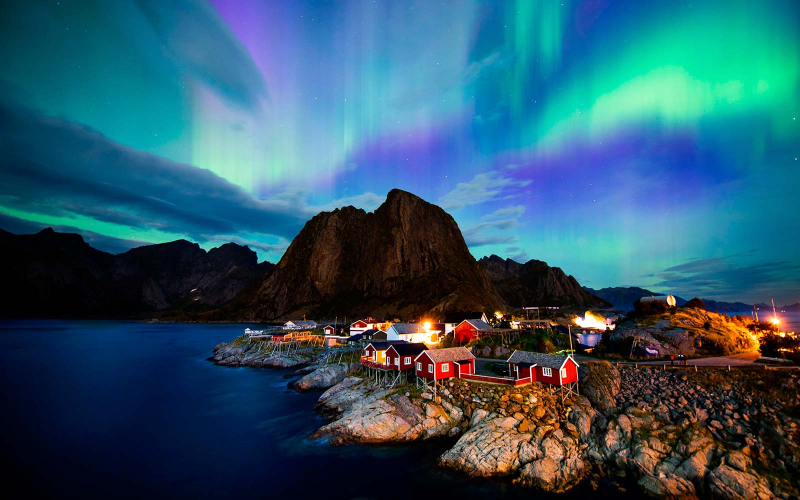The northern lights are one of a few different types of astronomical phenomena called polar lights. Also known as aurora borealis, the bright lights of the aurora are actually collisions between electrically charged particles from the sun entering the atmosphere of the earth.
Because the phenomena occur near the magnetic poles, one of the best places to watch the lights is over the northern coast of Norway. However, understandably there is a lot of confusion surrounding how best to set off in search of the northern lights in Norway. Talking about magnetic poles, I have often wondered about weird scientific questions. Not to forget that my friends are also like that. I say that because one of my friends once asked me, “can Earth’s magnetic poles flip?” I do not remember if I gave him an answer but I surely remember taking inspiration from him for asking such weird questions.
Any, enough of the weird stuff, let us now discover 3 important things to keep in mind before booking a trip to Norway to see the northern lights.
-
Always Travel During the Best Time of Year to See the Northern Lights
Generally speaking, if you want to see the northern lights in Norway then planning your trip for the middle of summer, when the sun never sets, should be avoided at all costs. That being said, the best time to see the northern lights is not necessarily at the darkest time of the year either.
Essentially, the midnight sun of the Arctic Circle makes it impossible to see the lights during the summer, but the longer darker winter nights are usually more conducive to viewing the lights in action.
In November, December, and January, the weather in Norway can be relentless and unwelcoming so therefore the months of September, October, February, and March are much more inviting. Although the weather cannot be predicted with 100% accuracy, if you want to optimize your chances of seeing the lights, visiting during these months is strongly recommended.
Be sure to lookout through the night to maximize your opportunity to witness the lights in person. You might even want to set an alarm on the hour, every hour, after dusk as a reminder to look outside. Some hotels even offer an aurora wake-up service so that you can avoid missing out.
-
Pick Your Location Carefully
Although it might be tempting to head as far north as possible in search of the northern lights, in reality, it is possible to miss the lights entirely by staying somewhere too north. Consequently, there are a few prime spots for seeing the northern lights in Norway.
Tromsø, lovingly referred to as ‘the capital of the Arctic’, is often cited as one of the best places in the world to view the northern lights. This small city is surrounded by spectacular fjords and craggy peaks that beautifully encapsulate the polar atmosphere.
Additionally, Kirkenes, the Lofoten Islands, the North Cape (Nordkapp), and Svalbard, should also make your shortlist of potential destinations and are all unique settings to see the lights up close and personal.
Norway has a relatively small population in comparison to its size and therefore the northern lights cannot be seen from everywhere in the country. Heading north of the Arctic Circle is vital if you want a good chance of seeing the lights.
That being said, you might even want to consider staying in accommodation that is at a distance from where you actually want to see the lights. Light pollution can seriously hamper your views of the skies, and therefore being able to head out to the countryside away from towns, cities, and large resorts enables you to enjoy the lights unhindered by artificial light.
-
Always Book Other Activities and Excursions
Unfortunately, even if you follow all the advice and guidance above there are no guarantees that you will get to see the northern lights. You might simply be in the wrong place at the wrong time. To avoid setting yourself up for disappointment it is therefore vital that you fill your days with other activities so that you can still make memories that will last a lifetime.
Besides, it is no secret that staying in the north for as long as possible greatly increases your chances of witnessing the magic of the lights for yourself. Most travellers find that 4 days up to a week is the optimal amount of time if you want to enjoy a leisurely trip to Norway.
The Arctic Circle has a lot to offer for nature and history lovers besides the lights, including dog sledding, winter sports, whale watching, and tours of Norway’s Viking past, so be sure to schedule a mixture of day-time and night-time activities to experience the local culture and to keep yourself busy.
Ultimately, it is undeniable that the aurora borealis is one of the most extraordinary sights in the world. Above all, by planning your trip to Norway carefully, you should be able to witness the wonders of the northern lights while also enjoying an enriching and revitalizing experience that enables you to soak up the Norwegian culture and lifestyle.
